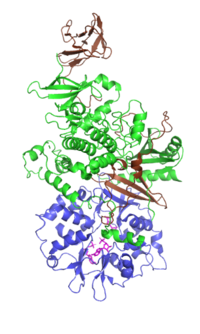
Photo from wikipedia
A small-molecule inhibitor of the kinase TPL2 shows efficacy in rodent models of inflammation. Targeting inflammatory neutrophils Neutrophils and monocytes are innate immune cells that establish an inflammatory response to… Click to show full abstract
A small-molecule inhibitor of the kinase TPL2 shows efficacy in rodent models of inflammation. Targeting inflammatory neutrophils Neutrophils and monocytes are innate immune cells that establish an inflammatory response to infection. Because of their numbers, neutrophils produce substantial amounts of inflammatory cytokines; thus, targeting them specifically would help in the treatment of chronic inflammatory diseases. Senger et al. found that the kinase TPL2, which activates the ERK family of mitogen-activated protein kinases (MAPKs) in immune cells, also stimulated p38 MAPK activity specifically in neutrophils. TPL2 activity was greater in tissues from patients with Crohn’s disease or rheumatoid arthritis than in those from healthy donors. Mice with a kinase-deficient form of TPL2 or that were treated with a small-molecule inhibitor of TPL2 had decreased neutrophil-dependent inflammation, which suggests that targeting TPL2 may provide a therapy to treat patients with inflammatory diseases. Tumor progression locus 2 (TPL2; also known as MAP3K8) is a mitogen-activated protein kinase (MAPK) kinase kinase (MAP3K) that phosphorylates the MAPK kinases MEK1 and MEK2 (MEK1/2), which, in turn, activate the MAPKs extracellular signal–regulated kinase 1 (ERK1) and ERK2 (ERK1/2) in macrophages stimulated through the interleukin-1 receptor (IL-1R), Toll-like receptors (TLRs), or the tumor necrosis factor receptor (TNFR). We describe a conserved and critical role for TPL2 in mediating the effector functions of neutrophils through the activation of the p38 MAPK signaling pathway. Gene expression profiling and functional studies of neutrophils and monocytes revealed a MEK1/2-independent branch point downstream of TPL2 in neutrophils. Biochemical analyses identified the MAPK kinases MEK3 and MEK6 and the MAPKs p38α and p38δ as downstream effectors of TPL2 in these cells. Genetic ablation of the catalytic activity of TPL2 or therapeutic intervention with a TPL2-specific inhibitor reduced the production of inflammatory mediators by neutrophils in response to stimulation with the TLR4 agonist lipopolysaccharide (LPS) in vitro, as well as in rodent models of inflammatory disease. Together, these data suggest that TPL2 is a drug target that activates not only MEK1/2-dependent but also MEK3/6-dependent signaling to promote inflammatory responses.
Journal Title: Science Signaling
Year Published: 2017
Link to full text (if available)
Share on Social Media: Sign Up to like & get
recommendations!